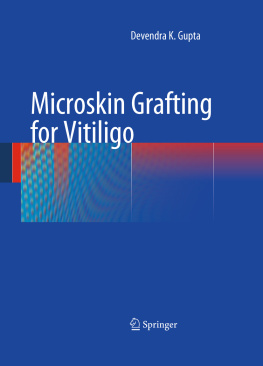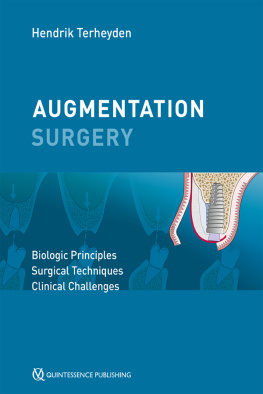Devendra K Gupta Microskin Grafting for Vitiligo 10.1007/978-1-84882-605-2_1 Springer Dordrecht Heidelberg London New York 2009
1. Surgical Therapies
Abstract
Vitiligo is a relatively common pigmentary disorder (affecting nearly 12 % of population) of great socio-medical importance. Depigmentation of the skin with the loss of melanocytes on histology characterizes this disorder. It is defined as a circumscribed, acquired, idiopathic, progressive, hypomelanosis of skin and hair, often familial and characterized by total absence of melanocytes microscopically. This definition excludes postinflammatory, chemically induced depigmentation, and those which are associated with melanoma, secondary to various dermatoses and after burns. A range of clinical phenotypes lead to varying degrees of morbidity. The cause of vitiligo remains unknown, although an autoimmune pathogenesis seems most likely. Treatment also remains difficult. A number of new therapies show significant potential. Vitiligo presents as sharply demarcated depig-mented macules, that can appear anywhere on the skin. There is a predilection for orifices eyes, nostrils, mouth, nipples, umbilicus, and genitalia.1 The natural history of the disorder is either that it spreads quite quickly (over months) and then is stable, or it relentlessly spreads over the body with time (over years). Sites of trauma (koebnerization), such as the elbows, may develop vitiligo.1 Twenty-three to twenty-six percent of patients are children under the age of twelve.24 It is the most commonly acquired hypomelanosis.5
1.1 Introduction
Vitiligo is a relatively common pigmentary disorder (affecting nearly 12 % of population) of great socio-medical importance. Depigmentation of the skin with the loss of melanocytes on histology characterizes this disorder. It is defined as a circumscribed, acquired, idiopathic, progressive, hypomelanosis of skin and hair, often familial and characterized by total absence of melanocytes microscopically. This definition excludes postinflammatory, chemically induced depigmentation, and those which are associated with melanoma, secondary to various dermatoses and after burns. A range of clinical phenotypes lead to varying degrees of morbidity. The cause of vitiligo remains unknown, although an autoimmune pathogenesis seems most likely. Treatment also remains difficult. A number of new therapies show significant potential.
Vitiligo presents as sharply demarcated depig-mented macules, that can appear anywhere on the skin. There is a predilection for orifices eyes, nostrils, mouth, nipples, umbilicus, and genitalia.
The typical Vitiligo macules have a well defined light tan border and are chalky or snow white (trichrome Vitiligo),. Sometimes there may also be a hyperpigmented border or a red halo (inflammatory vitiligo).
Segmental Vitiligo presents in dermatomal, multi-dermatomal, quasidermatomal forms which are arranged unilaterally. Most patients do not develop lesions elsewhere. Vitiligo of distal digits and the lips produces the lip-tip syndrome. Bilateral lesions may be symmetrical or asymmetrical. Palms and soles are commonly involved. Mucosal depigmentation, including gingiva, genitalia, lips and nipples, leukotrichia depigmented hair is common in Vitiligo patches.
Vitiligo can be extremely disfiguring, leading to significant patient morbidity. A number of different studies have been carried out to measure the quality of life for patients with vitiligo. Low self-esteem, poor body image and poor quality of life has been found in patients with vitiligo, including significant psychiatric morbidity (up to 25 % in one study).
Vitiligo or Leukoderma as it is more familiarly known in many parts of the world has gained importance principally because of the serious social stigma especially in the dark skinned people. It can be devastating to their self esteem because the sufferer may face problems related to matrimonial alliance or even in getting employment. It is very common in the countries like Pakistan, India and Bangladesh.
1.2 Course and Prognosis
Vitiligo is a chronic disease process. The course is highly variable but rapid onset followed by a period of stability or slow progress is most characteristic. Up to 30 % may report some spontaneous repigmentation particularly in sun-exposed areas. Rapidly progressive or galloping Vitiligo may lead to extensive depigmentation.
Vitiligo zosteriformis/segmental, however, is the most stable form and may show a better prognosis. Segmental Vitiligo is a special subset which usually develops precipitously in a region, which does not usually extend beyond quasidermatomal region, and is very stable, once present.
A few of the cases may once again start progressing at a rapid pace after a period of dormancy. Such an occurrence is not uncommon in nonsegmental vitiligo types namely vitiligo vulgaris, acrofacialis and areata. In addition, several other factors may assist in evaluating its prognosis, (a) the younger the patient, the shorter the duration, the better is the prognosis, (b) the lesions located on the fleshy regions of the body may show better chance of recovery in contrast to that on bony/friction points and (c) the presence of leukotrichia or lesions on mucous membranes or mucocutaneous junctions may account for a poor prognosis.
Another important aspect in the management of vitiligo is to identify the prognostic factors in each patient as this would be essential to decide on the end point of any modality of therapy. In my experience, a poor prognostic factor includes history of progression, family history of vitiligo, widespread disease, nonseg-mental vitiligo, acrofacial vitiligo. I would also advise that all patients of vitiligo should be given sunscreens, antioxidants and options regarding cosmetic camouflage. Finally, the management of vitiligo would not be complete without good counseling, motivation and psychological support to the patient.
1.3 Surgical Therapies
The most frequently used treatment for vitiligo is PUVA (psoralen plus ultraviolet A) and/or topical or systemic steroids. It has been reported that these standard treatments result in limited success rates (about 60 % of patients achieve more than 25 % repig-mentation). These refractory and stable vitiligo can be subjected to various surgical therapies.
All the surgical therapies used in vitiligo are categorized into either the tissue grafts or the cellular grafts. The tissue grafts are simple ones and used to give good repigmentary results without the need of hitech laboratory and infrastructure, but the disadvantage is that, only limited vitiliginous area can be treated at a time. The cellular grafts are the latest one to be used in vitiligo and include both cultured and non cultured melanocytes and promise to cover wide vitiliginous area in one operative session with limited donor site. The tissue grafts includes split thickness skin grafts, mini punch grafts, hair follicle grafts and suction blister epidermal grafts. These current surgical treatments for stable refractory vitiligo are over-viewed.
1.4 Split Thickness Skin Sheet Grafting
This method removes the epidermis and superficial papillary dermis of vitiligo depigmented areas by dermabrasion, and replaces it with very thin dermo-epidermal grafts harvested from normally pigmented donor skin with a dermatome. Although the method is simple, the motor-driven diamond fraise or wire brush used for dermabrasion at recipient sites sometimes leaves a hypertrophic scar if dermabrasion is done deeply and harvesting excessively thick grafts can also result in hypopigmentation or slight scarring at donor sites. Apart from this there is characteristic recipient area deformities like achromic fissuring, stuck-on appearance, perigraft hypopigmented halo and rolled up peripheral margin.











